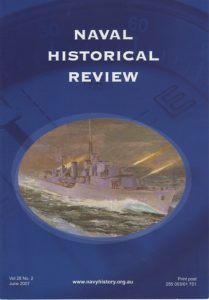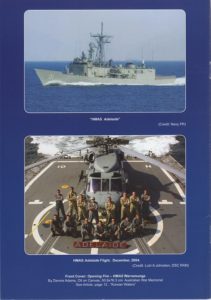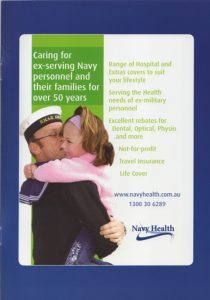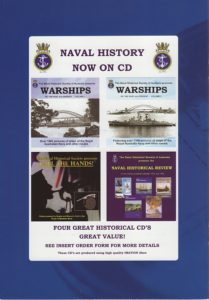On This Day
1900-1913 > Federation, RAN and pre-WW1
On This Day - 1900-1913
- September 10, 1905
VADM Sir Wilmot H. Fawkes, KCB, KCVO, was appointed Flag Officer Commanding the Australia Station. His flagship was HMS POWERFUL
- July 18, 1905
The naval prison at Garden Island, Sydney, was completed. It provided accommodation for 12 prisoners.
- January 12, 1905
Commonwealth Naval and Military Boards were constituted under the Defence Act of 1903-1904. The regular members of the Naval Board were the Minister for Defence, (Mr J. W. McKay) as President, the Director of Naval Forces, (CAPT William Creswell), and a civilian as finance member, (Mr J. A. Thompson). CMDR F. Brownlow, (Officer Commanding Naval Forces New South Wales), was named as consultative member.
- December 24, 1904
CAPT William Creswell was appointed Director of Naval Forces.
- November 10, 1904
Water tender RIPPLE, built by Foster & Minty, Balmain, NSW, underwent trials at Sydney. It served in the RAN from 1913 to
- March 1, 1904
Control of State Defence Forces was formerly transferred to the Commonwealth of Australia.
- November 17, 1903
The Daily Telegraph, Sydney reported:- ‘New Survey Ship For Australia. The British Admiralty has purchased the yacht CONSUELO, (owned by the 26th Earl of Crawford and Balcarres), for survey work in Australian waters’. The vessel was a screw schooner of 270 tons displacement, 50 metres long and 8.2 metres beam, built in 1887 by Robert Steele & Co., Greenock, Scotland. She was commissioned HMS INVESTIGATOR in 1903, and in 1904 changed to HMS SEALARK. She sailed from Portsmouth in September 1904. In 1919 the vessel was sold to the Patrick Steam Company, Sydney.
Subsequently her name was changed to SEALARK III in 1920, NORWEST in 1923, had a change of owner to William Waugh Ltd in 1925, and was removed from registry on 26/05/1925.
The figurehead depicting Helen Elizabeth Lambert, (daughter of the first owner Charles Lambert), was presented to the Naval Dockyard, Garden Island.
- August 3, 1903
The first Marines Corps formed in Australia were the New South Wales Marine Light Infantry, recruited as the Third Contingent to join New South Wales’ volunteers in South Africa. The unit sailed in the transport SALAMIS for China.
- July 3, 1903
Imperial ships of the Australia Station were:- ROYAL ARTHUR, (1st class cruiser); ARCHER, PHOEBE, and PYLADES, (3rd class cruisers); LIZARD, and TORCH, (gunboats).
- April 9, 1903
The first message received from a ship at sea to an Australian wireless station was transmitted by the Queensland gunboat, GAYUNDAH, to a receiving station in Brisbane. The historic message read:- ‘Gun drill continued this afternoon and was fairly successful-blowing squally and raining -prize firing tomorrow. Marconi insulators were interfered with by rain but easily rectified and communication since has been good. Good night.’ The ship’s aerial was a tall bamboo pole lashed to the mast.
- January 6, 1903
Alfred Deakin, (later to become Prime Minister of Australia), and in his time the greatest political champion of Australian defence, wrote in the Morning Post; ‘The idea of a specially Australian navy manned by colonial sailors and under our own executive direction has been assiduously preached of late and that it has ‘caught on’ with the masses…’.
- November 10, 1902
VADM Sir Arthur D. Fanshawe, KCB, RN, was appointed Flag Officer Commanding the Australia Station. His flagship was HMS ROYAL ARTHUR.
- October 22, 1902
The Australian Star reported that the NSW Government had purchased the mansion ‘Tresco’ at Elizabeth Bay, as a residence for the Naval Officer-in-Command at Garden Island, Sydney.
- June 18, 1902
HMS ENCOUNTER, (cruiser), later HMAS ENCOUNTER, was launched at Devonport, England.
- February 11, 1902
Anglo-Japanese treaty signed. The treaty required Britain and Japan to join the other in the event of hostilities. Australian naval policy was strongly influenced by this treaty. It expired on 13 July 1921.
- September 28, 1901
CAPT William Creswell, RN, submitted his historic report on Australian sea defence, commerce, and ports.
- March 29, 1901
Transport 106, (China Navigation Company vessel SS CHINGTU), sailed from Hong Kong returning troops to Australia
- March 1, 1901
The order was gazetted that all Australian armed forces should be transferred from the jurisdiction of the State Governments to the Federal Government, which under the Federal Constitution, would be the sole Australian Defence authority. The Commonwealth Naval Force came into existence. It’s war equipment consisted of a motley collection of largely obsolescent warships, including, HMC Ships CERBERUS and PROTECTOR, torpedo boats CHILDERS, COUNTESS OF HOPETOWN, LONSDALE, NEPEAN, and MOSQUITO, gunboats GAYUNDAH and PALUMA, and a number of small naval auxiliaries. Naval personnel strength was 240 permanent members, and 1348 members of the Naval Brigade.
- January 17, 1901
Sir John Forrest was appointed Defence Minister, and CAPT R. Muirhead Collins, (former RN officer), became Secretary of Defence in the Commonwealth administration.
- January 6, 1901
The gunboat, HMCS PROTECTOR, (CAPT William Creswell, RN), arrived back in Port Adelaide after 153 days away, serving in China from September to November 1900, during the Boxer rebellion.
- January 3, 1901
The Imperial Squadron based in Sydney consisted of HM Ships ROYAL ARTHUR, (1st class cruiser); PORPOISE and ARCHER, (torpedo cruisers); PYLADES, (composite steam corvette); RINGDOVE, (composite steam gunboat), and TORCH, (sloop). The Australian Auxiliary Squadron, also based in Sydney, consisted of HM Ships KATOOMBA, RINGAROOMA, TAURANGA, WALLAROO, and MILDURA, (Phoebe 3rd class protected cruisers); KARRAKATTA and BOOMERANG,(Sharpshooter class torpedo gunboats); DART, (screw schooner); LIZARD, (1st class gunboat), and PENGUIN, (composite screw sloop).
- January 1, 1901
The effective strength of the NSW Naval Brigade was 416 officers and men.
- November 24, 1900
The former South Australian gun boat HMS PROTECTOR, was decommissioned at Hong Kong, and adopted her former prefix HMSAS.
- November 6, 1900
AB J. Hamilton, of the New South Wales Marine Light Infantry, died at Tung Chao in China. He was the first sailor to die in an Australian expeditionary force overseas.
- November 1, 1900
RADM Sir Lewis A. Beaumont, KCMG, RN, was appointed Flag Officer Commanding the Australia Station. His flagship was HMS ROYAL ARTHUR.



